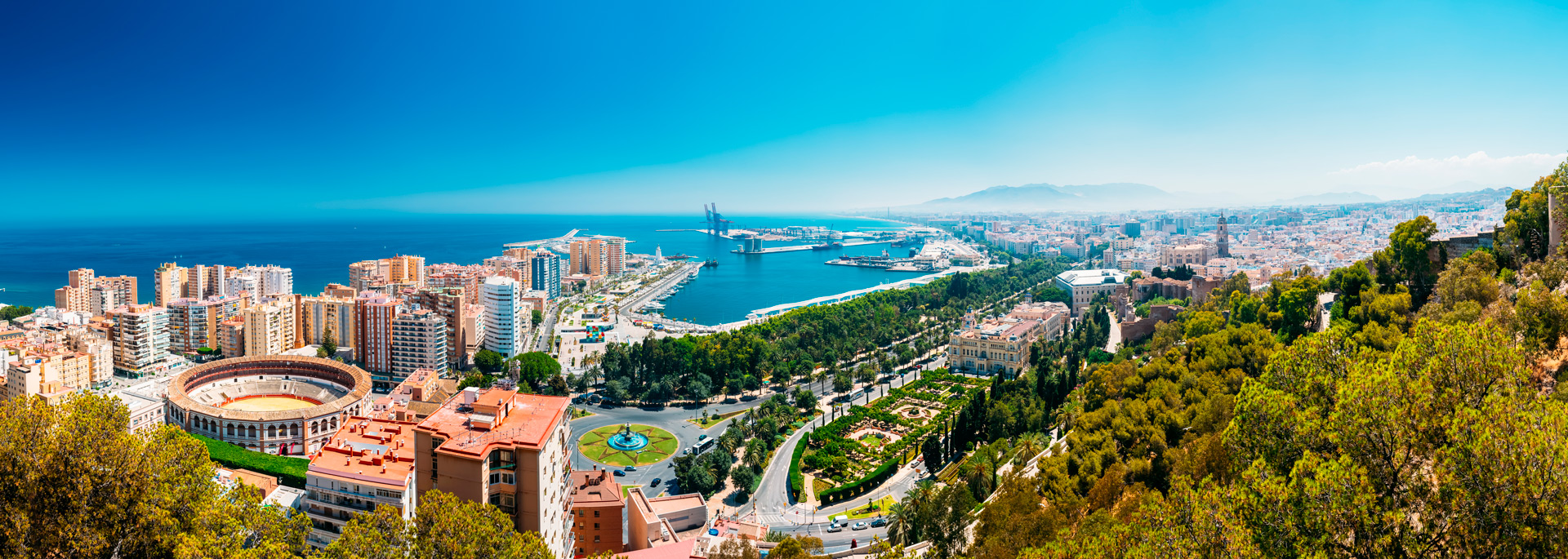

Capital of «Costa del Sol», a beautiful mediterranean city
The city of Malaga is located in a privileged enclave. The municipality extends over an area of 398.25 square kilometres and its «de facto» urban population reaches the million inhabitants mark.
The main environmental and geographical factors that have intervened in the city’s evolution and development have been maritime influences, its location in two river valleys (the Guadalhorce and the Guadalmina), its relief and its climate.
GEOGRAPHICAL DATA
Province
Surface area: 7,276 Sqkm.
Population: 1.641.098 inhabitants (2012)
Municipality of Malaga
Surface Area: 398.25 SqKm.
Population: 567.433 inhabitants (2012)
Whilst the Mediterranean Sea bathes the Malaga coastline, the Malaga Mountains close ranks behind to form a barrier of peaks that protects the city from the cold, whilst the regulating effect of the sea ensures the area its characteristic mild temperatures. The hottest months are July and August and the coldest are usually December and February, when the average temperatures vary between a maximum of 22.8ºC and a minimum of 13ºC. Rainfall in Malaga follows the seasons, with the most abundant rains occurring in autumn and winter.
At the mouth of the River Guadalhorce, river sediments have formed the area known as the «Guadalhorce Mudflats». Declared a Protected Natural Space in 1989, they currently occupy an area of 60 hectares. The other river that has played a decisive role in the history of Malaga is the Guadalmedina, which in Arabic means «the river of the city». It is 47 kilometres long and is fed mostly by the waters that run down from the Malaga Mountains.
The Malaga Mountains were declared a National Park in 1989. This gave greater protection to an area of 4,762 hectares, of which 97% is located within the municipality of Malaga. Its relief is steep and rugged, with summits that reach an average altitude of 500 metres. Its tree cover originates from the hydrological-forestry reforestations carried from the end of the 30s and the area contains over 230 different varieties of vegetation and more than 160 species of vertebrates.
Suscríbete a nuestro boletín mensual para recibir todas las noticias.

Nam porttitor blandit accumsan. Ut vel dictum sem, a pretium dui. In malesuada enim in dolor euismod
Nam porttitor blandit accumsan. Ut vel dictum sem, a pretium dui. In malesuada enim in dolor euismod

Nam porttitor blandit accumsan. Ut vel dictum sem, a pretium dui. In malesuada enim in dolor euismod

Nam porttitor blandit accumsan. Ut vel dictum sem, a pretium dui. In malesuada enim in dolor euismod
Nam porttitor blandit accumsan. Ut vel dictum sem, a pretium dui. In malesuada enim in dolor euismod

Nam porttitor blandit accumsan. Ut vel dictum sem, a pretium dui. In malesuada enim in dolor euismod

Nam porttitor blandit accumsan. Ut vel dictum sem, a pretium dui. In malesuada enim in dolor euismod
Nam porttitor blandit accumsan. Ut vel dictum sem, a pretium dui. In malesuada enim in dolor euismod

Nam porttitor blandit accumsan. Ut vel dictum sem, a pretium dui. In malesuada enim in dolor euismod

Nam porttitor blandit accumsan. Ut vel dictum sem, a pretium dui. In malesuada enim in dolor euismod
Nam porttitor blandit accumsan. Ut vel dictum sem, a pretium dui. In malesuada enim in dolor euismod

Nam porttitor blandit accumsan. Ut vel dictum sem, a pretium dui. In malesuada enim in dolor euismod
| Cookie | Duración | Descripción |
|---|---|---|
| cookielawinfo-checbox-analytics | 11 months | Esta cookie la establece el complemento de consentimiento de cookies del RGPD. La cookie se utiliza para almacenar el consentimiento del usuario para las cookies en la categoría "Análisis". |
| cookielawinfo-checbox-functional | 11 months | La cookie se establece mediante el consentimiento de cookies del RGPD para registrar el consentimiento del usuario para las cookies en la categoría "Funcional". |
| cookielawinfo-checbox-others | 11 months | Esta cookie la establece el complemento de consentimiento de cookies del RGPD. La cookie se utiliza para almacenar el consentimiento del usuario para las cookies en la categoría "Otros". |
| cookielawinfo-checkbox-necessary | 11 months | Esta cookie la establece el complemento de consentimiento de cookies del RGPD. Las cookies se utilizan para almacenar el consentimiento del usuario para las cookies en la categoría "Necesarias". |
| cookielawinfo-checkbox-performance | 11 months | Esta cookie la establece el complemento de consentimiento de cookies del RGPD. La cookie se utiliza para almacenar el consentimiento del usuario para las cookies en la categoría "Rendimiento". |
| viewed_cookie_policy | 11 months | La cookie la establece el complemento GDPR Cookie Consent y se utiliza para almacenar si el usuario ha dado su consentimiento o no para el uso de cookies. No almacena ningún dato personal. |